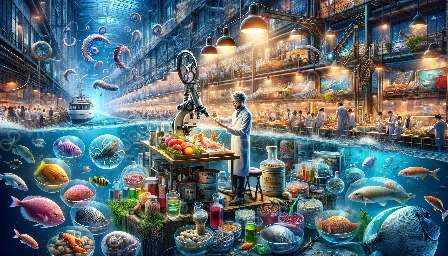The seafood supply chain is a complex and dynamic network of businesses involved in the harvesting, processing, and distribution of seafood products, which directly influences the marketing, economics, and scientific aspects of the seafood industry. To truly understand the intricate connections within the seafood supply chain, it's essential to delve into its various stages, including sourcing, processing, distribution, and consumer engagement.
Seafood Sourcing and Harvesting
Seafood supply chains begin with the sourcing and harvesting of aquatic species, whether from oceans, rivers, or aquaculture. Sustainable sourcing has become increasingly critical due to concerns about overfishing and environmental impact. Effective sourcing strategies involve collaboration between fishermen, aquaculturists, and regulatory bodies to ensure responsible and ethical practices in harvesting seafood.
Impact on Seafood Marketing
The sourcing and harvesting stage directly impact seafood marketing efforts. Consumers are increasingly demanding sustainably sourced and traceable seafood, driving the need for transparent supply chains. Marketing initiatives often highlight the origin and sustainability practices of seafood to attract environmentally conscious consumers. A transparent and responsible sourcing strategy positively influences consumer perceptions and purchasing decisions.
Seafood Processing and Distribution
Once harvested, seafood undergoes various processing stages, including cleaning, cutting, freezing, and packaging, before being distributed to wholesalers, retailers, and restaurants. Efficient processing and distribution practices are crucial for maintaining seafood freshness and quality throughout the supply chain. Additionally, stringent quality control measures are essential to ensure food safety and meet regulatory standards.
Economic Implications
The processing and distribution stages significantly impact the economics of the seafood industry. Factors such as production costs, logistics, and market demand influence pricing and profitability. Effective supply chain management can optimize operational efficiencies, reduce waste, and enhance overall economic performance, benefiting both suppliers and consumers.
Consumer Engagement and Seafood Science
Consumer engagement with seafood products is greatly influenced by the scientific aspects of the supply chain. Advances in seafood science, including food safety, nutritional value, and sustainability research, drive consumer confidence and product innovation. Understanding the scientific intricacies of seafood supply chains is crucial for promoting informed consumer choices and cultivating trust in seafood products.
Aligning Marketing, Economics, and Science
The intersection of seafood supply chain management, marketing, economics, and science underscores the importance of aligning these elements to create a sustainable and prosperous seafood industry. Harmonizing marketing efforts with economic considerations and scientific advancements can foster a comprehensive approach to seafood supply chain management, addressing consumer preferences, industry sustainability, and economic viability simultaneously.
The Future of Seafood Supply Chain Management
As the seafood industry continues to evolve, the future of supply chain management will likely be shaped by technological innovations, sustainability initiatives, and market dynamics. Embracing digital platforms for traceability, implementing advanced processing technologies, and prioritizing sustainability practices are anticipated to drive positive changes within the seafood supply chain, further influencing marketing strategies, economic models, and scientific advancements.
In conclusion, the seafood supply chain serves as a multifaceted platform that intersects with marketing, economics, and science, exerting influence at every stage of the industry. Understanding the complexities of seafood supply chain management and its impact on marketing, economics, and science is crucial for all stakeholders, from suppliers to consumers, in fostering a sustainable and thriving seafood industry.

